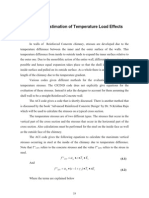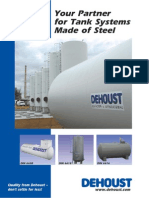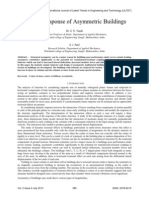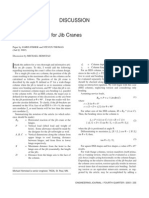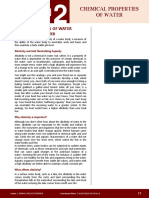Short Circular Steel Stacks
Uploaded by
kselvan_1Copyright:
Available Formats
Short Circular Steel Stacks
Uploaded by
kselvan_1Original Description:
Copyright
Available Formats
Share this document
Did you find this document useful?
Is this content inappropriate?
Copyright:
Available Formats
Short Circular Steel Stacks
Uploaded by
kselvan_1Copyright:
Available Formats
Internati onal Journal of Engineering Technol ogy Science and Research
IJ ETS R
www.ijetsr.com
ISSN 2394 3386
Volume 2, S pecial Issue
September 2015
Correlation of Geometry and Dynamic Response of SelfSupported Short Circular Steel Stacks
Harshal Deshpande 1 , Post Graduate Student in Structural Engineering,
Saraswati College of Engineering, Kharghar
Roshni John2 , Assistant Professor, Saraswati College of Engineering, Kharghar
ABSTRACT
Steel stacks are smoke releasing slender structures constructed in various industries. They are subjected to static and
dynamic loadings. Dynamic analysis is carried out by considering both seismic loading and dynamic wind loadings.
Apparently dynamic wind effects are critical for steel stacks and they govern the stability conditions. Steel stacks being
slender and long sections they are more prone to dynamic wind oscillations and corresponding stresses. Present study
deals with interrelation of geometrical configuration and obtained dynamic response of short self-supported steel stacks
under dynamic wind loadings and seismic loadings. 42 steel stack configurations for 7 different heights of stacks are
selected and analyzed for dynamic wind loadings and seismic loadings as per Indian standards (IS:6533 part2)and IS
1893(part 4). a relation between dynamic response and governing geometry of the stack is found out. Use of excel sheets
and STAAD-proV8i software is done for analysis.
Keywords
Dynamic wind response, steel stacks, analysis of dynamic wind for slender stacks, oscillations of steel stacks.
1. INTRODUCTION
Stacks or chimneys are very important industrial structures for releasing out waste harmful gases to a higher
elevation in atmosphere. Stack structures are tall, slender and tapering with circular cross-sections. Steel
stacks are ideally suited for works involving short heating period and less thermal capacity. Fig. 1.1 shows
chimneys located in an industrial campus.
Fig.1.1 industrial steel stacks
133
Harshal Deshpande 1 , Roshni John2
Internati onal Journal of Engineering Technol ogy Science and Research
IJ ETS R
www.ijetsr.com
ISSN 2394 3386
Volume 2, S pecial Issue
September 2015
1.1Analysis of Steel Stacks
1.1.1 forces acting on steel stacks
Steel chimneys or stacks are basically under the influence of following loads
1. Static load
2. Dynamic wind load
3. Seismic loads
Static loads include self-weight and weight of lining and other components of stacks. (Ref.IS
6533(part1):1989)It also includes static wind loads and corresponding static wind pressures. (Ref. IS
875(part3):1987).Dynamic wind effects include along wind and across wind effects .this includes the drag
forces and the vortex excitation along with aerodynamic forces acting on stack causing stacks to
oscillate(ref.IS 6533(part 2):1989). 3. Seismic effects include the effect of dynamic force exerted on the steel
stacks during earthquakes. in current work response spectrum method is used to analyze the selected steel
stacks.
1.2 Geometry of steel stacks
Geometry of a stack or a chimney plays an important role in the process of analysis as it affects the stiffness
parameters. (Ref. IS 6533:1989 part2). Basic geometry of steel stack is governed by top diameter (D t), base
diameter (Db ) and effective height of stack (H e). Following IS codes are used for the analysis of steel stack.
1. IS 6533 (Part-1): 1989 Indian standard design and construction of steel stacks-code of practice Mechanical aspects.
2. IS 6533 (Part-2): 1989 Indian Standard Code of practice for design and construction of steel chimneys
"structural aspects.
3. IS 875 (Part-3):1987: For calculation of wind loads
4. IS 1893 (Part-4):2005: This code covers the seismic considerations to be followed for the design .Seismic
zones and formulae based on design considerations will be included from this code.
2. FORMULATION OF RESEARCH PROBLEM
2.1 Description of selected steel stacks/chimneys
1.
Type of stack = circular self-supporting industrial steel stacks
2.
Heights of stacks: 30 m ,35m,40m,45m ,50m ,55m,60 m ( short stacks)
3.
Top diameter for each stack is taken as minimum h/30 as per provision in IS 6533 :1989
4.
Variation in base diameter for each stack for fixed value of top diameter will be in following
incremental ratios (ratio Db /Dt ) : 1.6,1.7,1.8,1.9,2.0,2.1
5.
Type: unlined single flume.
6.
Temperature inside chimney : 2000 c average
7.
Flare height: one third of total height.
8.
Thickness of stack shell= 16 mm ( constant for all stacks)
9.
Base : rigid
10.
location :Mumbai
11.
wind speed : 44m/s
12.
material :Mild steel
13.
variation in geometry : top to base diameter ratio in each configuration
14.
soil :medium (bearing capacity 200kN/m2 )
15.
seismic zone :III
134
Harshal Deshpande 1 , Roshni John2
Internati onal Journal of Engineering Technol ogy Science and Research
IJ ETS R
www.ijetsr.com
ISSN 2394 3386
Volume 2, S pecial Issue
September 2015
16.
damping :5%
17.
connections :welded joints
IS Codal provisions for geometry are the basis of variations in the geometry. Minimum top diameter of
unlined chimney should be one twentieth of the effective height of chimney /stacks and minimum
outside diameter at the base should be equal to 1.6 times the top diameter of the stack . (As per IS
6533(part2):1989 (reaffirmed in 2003) cl.7.2.4 (b) and (c).)Manual calculations are done for validating the
results of STAAD-pro v8i software results. Dynamic wind responses are calculated using MS-excel sheets and
seismic responses are calculated by STAAD-pro v8i.
Table 1 geometry of selected steel stacks
Total height of Effective
Top
Varying top to bottom diameters ratio.
stack
height
diameter
From minimum 1.6 and then increased by 0.1 up to 2.1
(Metres) (H)
(2/3 H)
(constant)
Dt/ Db ratio
(Metres)
(H/30)
H
30
35
40
45
50
55
60
He
20
23.33
26.66
29.97
33.33
36.3
40
Dt (m)
1
1.16
1.33
1.5
1.66
1.83
2.00
1.6
Db (m)
1.6
1.856
2.128
2.4
2.656
2.928
3.2
1.7
Db (m)
1.7
1.972
2.261
2.55
2.822
3.111
3.4
1.8
Db (m)
1.8
2.088
2.394
2.7
2.988
3.294
3.6
1.9
Db (m)
1.9
2.204
2.527
2.85
3.154
3.477
3.8
2.0
Db (m)
2.0
2.32
2.66
3.00
3.32
3.66
4.00
2.1
Db (m)
2.1
2.436
2.793
3.15
3.486
3.843
4.2
3. Methodology
3.1 general procedures for dynamic analysis
Chart1: Schematic Representation of Dynamic Analysis
3.2 dynamic wind sample calculations (as per IS 6533 (part2):1989)
Dynamic wind response includes dynamic force, dynamic moment and corresponding deflections
Calculations are done by using excel sheets .total 18 excel sheets are prepared for iterative calculations.
Sample calculation results for 30m chimney are shown in short below.
135
Harshal Deshpande 1 , Roshni John2
Internati onal Journal of Engineering Technol ogy Science and Research
IJ ETS R
www.ijetsr.com
ISSN 2394 3386
Volume 2, S pecial Issue
September 2015
Table 3.2 Sample Calculation for 30 M Chimney with 1m Top Diameter and 1.6m Base Diameter
Cumm. Ht
5
10
15
20
25
30
Segmental Ht.
P static
(N)
5938.3
4709.7
4672.9
5079.0
5341.5
5610.5
Yik & Yij
Time Period
(Sec)
0.685
0.685
0.685
0.685
0.685
0.685
Mk & Mj
i from table 5 IS 6533 p.2
0.025
0.025
0.025
0.025
0.025
0.025
Unlined
2.502
2.502
2.502
2.502
2.502
2.502
0.6
0.6
0.575
0.55
0.5325
0.515
5
10
15
20
25
30
kg
2884
2280.6
1979
1979
1979
1979
0.7
0.7
0.7
0.7
0.7
0.7
ij
Pdyn
staad
0.0223
0.1037
0.265
0.4859
0.7377
1.0
Mk
0.045
0.2089
0.5339
0.9789
1.486
2.0145
Newton
2.28
8.37
18.565
34.037
51.673
70.049
Pk (Kn)
5.94
4.72
4.69
5.11
5.39
5.68
3.3 Seismic Response sample Calculations (for 30 m chimney)(IS 1893 (part4):1989)
Seismic Zone = Zone III, Zone Factor (Z) = 0.16
Importance Factor (I) = 1.5
Response Reduction Factor (R) = 2.0
Fundamental Time Period (T) = CTWt.hEs.A.g = 0.665s
Fundamental Time Period for Flared Structure (Te) = T/2 = 0.3325s
Radius of Gyration (re) = 12(Db2 ) = 0.565m
Base Diameter (Db) = 1.6m
Slenderness ratio (k) = h/ re = 53.09
Coefficient (CT) = 1.8*k = 95.57
Weight of Stack = 254kN (As per STAAD.Pro)
Elastic Modulus of Steel = 200000 MPa
Cross sectional Area at the base of shell (A) = .Db.Ts = 0.08 sq.m
Acceleration due to gravity (g) = 9.81 m/s 2
Design horizontal acceleration spectrum value (Ah) = (Z2).(Sag)(RI) = 0.15
Spectral acceleration coefficient (Sa/g) = 2.5 (As per Clause 6.4.5 of IS 1893(Part-1): 2002 for Medium soil)
Design Static Seismic Base Shear (Vb) = Cv. Ah. W. Dv = 57.15kN
136
Harshal Deshpande 1 , Roshni John2
Internati onal Journal of Engineering Technol ogy Science and Research
IJ ETS R
www.ijetsr.com
ISSN 2394 3386
Volume 2, S pecial Issue
September 2015
Table 3.2 Calculation of Base Shear:
Fundamental Time
Period (Sec)
Mode Shape
Coefficient ()
Wi.i
Wi.i
0.11
0.175
17.72
3.10
0.04
0.35
13.58
4.75
0.04
0.525
20.37
10.70
0.15
0.7
54.33
38.03
C1
1.87
Design Horizontal
Acceleration
Design Base
Shear (kN)
0.15
9.96
0.15
7.63
0.15
11.45
0.15
30.54
0.33
106.01 56.58
59.58
3.4 Sample Calculations for Dynamic Wind Loads by Excel Sheets and Seismic Responses by STAAD Prov8i
Fig 3.1 a) sample excel sheet for dynamic wind load
3.5 Seismic Loads Calculations models of 30 m ,45m and 60 m with 6 variations of top to base diameters are
modeled in STAAD-proV8i .for fundamental time period, frequency ,mode shapes ,von mises stresses
,principal stresses bending stresses, base shear and moments using response spectrum method.
137
Harshal Deshpande 1 , Roshni John2
Internati onal Journal of Engineering Technol ogy Science and Research
IJ ETS R
www.ijetsr.com
ISSN 2394 3386
Volume 2, S pecial Issue
September 2015
Fig 3.2 sample STAAD-pro model of a 30m chimney with first mode
Fig 3.3 absolute stresses on steel stack 45m
138
Harshal Deshpande 1 , Roshni John2
Internati onal Journal of Engineering Technol ogy Science and Research
IJ ETS R
www.ijetsr.com
ISSN 2394 3386
Volume 2, S pecial Issue
September 2015
Fig .3.4 maximum von mises stresses on steel stack 45 m
4. Results
Height (m)
30
35
139
Top Dia(m)
1.000
1.160
Table 4.1 Dynamic Wind responses
Bottom Dia(m) P (kN) V (kN) M (kN.m)
safe
safe
safe
1.600
128.312 31.537
475.919
Deflection (mm)
safe
48.535
1.700
130.290
31.938
477.303
45.547
1.800
132.260
32.341
478.706
43.017
1.000
134.240
32.745
480.125
40.851
2.000
136.212
33.149
481.557
38.980
2.100
138.185
33.554
483.000
37.350
1.856
174.012
43.842
776.346
68.725
1.972
176.683
44.388
778.523
64.495
2.088
179.350
44.935
780.741
60.911
2.204
182.020
45.483
782.980
57.843
2.320
184.693
46.033
785.240
55.192
2.436
187.363
46.583
787.525
52.883
Harshal Deshpande 1 , Roshni John2
Internati onal Journal of Engineering Technol ogy Science and Research
IJ ETS R
www.ijetsr.com
ISSN 2394 3386
Volume 2, S pecial Issue
September 2015
40
1.330
45
1.500
60
Height
(m)
30
35
140
2.000
Top
Dia(m)
1.000
1.160
2.128
228.390
59.255
1201.670
91.608
2.261
231.886
59.978
1204.969
85.962
2.394
235.385
60.703
1208.328
81.177
2.527
238.884
61.430
1211.738
77.082
2.660
242.382
62.159
1215.189
73.543
2.793
245.881
62.889
1218.679
70.461
2.400
2.550
290.137
294.576
77.265
78.192
1767.419
1772.188
118.399
111.097
2.700
299.015
79.123
1777.053
104.909
2.850
303.454
80.056
1781.999
99.612
3.000
307.893
80.992
1787.012
95.035
3.150
312.333
81.930
1792.081
91.048
3.200
517.061
127.03
3913.951
195.594
3.400
524.953
128.48
3923.701
183.522
3.600
532.845
129.91
3932.951
173.255
3.800
540.736
131.4
3943.901
164.518
4.000
548.628
132.85
3954.051
156.944
4.200
556.52
134.32
3964.401
150.339
Table 4.2 Seismic responses
Time period
Bottom Dia(m) (T) (sec.)
Frequency(f)
SRSS shear(kN)
Absolute
shear (kN)
1.600
1.700
0.3325
0.322
3.007
3.103
61.65
72.83
81.06
79.96
1.800
0.3125
3.192
78.83
78.92
1.000
0.3054
3.274
77.76
77.93
2.000
0.2985
3.349
60.58
77.01
2.100
0.2925
3.418
57.57
76.14
1.856
0.376
2.654
103.03
113.83
1.972
0.3664
2.729
82.33
112.51
2.088
0.3572
2.799
89.79
111.24
2.204
0.349
2.865
108.91
110.03
2.320
0.3417
2.926
78.29
108.88
Harshal Deshpande 1 , Roshni John2
Internati onal Journal of Engineering Technol ogy Science and Research
IJ ETS R
www.ijetsr.com
ISSN 2394 3386
Volume 2, S pecial Issue
September 2015
40
45
50
55
60
1.330
1.500
1.660
1.830
2.000
2.436
0.3293
3.037
76.02
106.73
2.128
0.4553
2.196
116.98
140.21
2.261
0.4352
2.297
126.28
137.37
2.394
0.4268
2.343
134.07
136.05
2.527
0.4191
2.386
101.7
134.79
2.660
0.4060
2.463
130.51
132.46
2.793
0.4003
2.498
93.33
131.38
2.400
0.4989
2.004
138.51
182.46
2.550
0.4834
2.069
153.76
179.97
2.700
0.4699
2.128
176.53
177.62
2.850
0.4583
2.182
132.27
175.4
3.000
0.4481
2.232
126.25
173.32
3.150
0.4391
2.277
165.6
171.36
2.656
2.822
0.5430
0.5324
1.841
1.878
165.8
166.33
230.23
228.34
2.988
0.5138
1.946
161.06
224.72
3.154
0.4980
2.008
210.88
221.34
3.320
0.4910
2.036
155.5
219.73
3.486
0.4786
2.089
157.65
216.69
2.928
0.6210
1.609
188.19
233.8
3.111
0.6010
1.664
238.00
238.2
3.294
0.5835
1.714
183.72
241.88
3.477
0.5684
1.759
174.62
244.95
3.660
0.555
1.80
180.00
247.5
3.843
0.5442
1.837
183.55
249.74
3.200
0.665
1.503
192.19
265.27
3.400
0.645
1.551
191.34
270.02
3.600
0.627
1.595
207.08
274.07
3.800
0.611
1.636
211.72
277.52
4.000
0.598
1.673
233.66
280.43
4.200
0.586
1.707
200.04
282.90
4.2 Conclusions and Discussions
Obtained results are graphically plotted as follows.
141
Harshal Deshpande 1 , Roshni John2
Internati onal Journal of Engineering Technol ogy Science and Research
IJ ETS R
www.ijetsr.com
ISSN 2394 3386
Volume 2, S pecial Issue
September 2015
Fig 4.1 Linear Response of dynamic wind force v/s Db/Dt ratio.
Fig.4.5 Linear Response of Dynamic shear At Base V/S H/Db Ratio
Fig.4.2 Linear Response of Dynamic Wind Force V/S H/Db Ratio
Fig.4.3 Linear Response of Dynamic Moment at Base V/S Db/Dt Ratio
142
Harshal Deshpande 1 , Roshni John2
Internati onal Journal of Engineering Technol ogy Science and Research
IJ ETS R
www.ijetsr.com
ISSN 2394 3386
Volume 2, S pecial Issue
September 2015
Fig.4.4 Linear Response of Dynamic shear At Base V/S Db/Dt Ratio
Fig.4.5 Linear Response of Time Period V/S H/Db Ratio
143
Harshal Deshpande 1 , Roshni John2
Internati onal Journal of Engineering Technol ogy Science and Research
IJ ETS R
www.ijetsr.com
ISSN 2394 3386
Volume 2, S pecial Issue
September 2015
Fig.4.5 Linear Response of modal frequency and frequency V/S Db/Dt Ratio
5. CONCLUSIONS
1.
From graphical representation it can be proved that for a self-supported steel stack unlined in
construction with constant shell thickness the change in geometry is directly proportional to the static
and dynamic response of the stack.
2.
Dynamic wind response as base moment, base shear, and fundamental modal frequency is linearly
increasing as the base diameter increases.
3.
Seismic responses such as absolute shear, fundamental time period and corresponding frequency are
linear functions of bottom to top diameter ratio and height to base diameter ratio.
REFERENCES
1.
2.
3.
5.
6.
7.
8.
9.
IS 1893 Part4; 2005, Criteria for Earthquake Resistant Design of Structures, Bureau of Indian Standards, New
Delh i (2002).
IS 6533 Part 1; 1989, Design and Construction of Steel Chimney, Bureau of Indian Standards, New Delhi
(2002).
IS 6533 Part 2; 1989, Design and Construction of Steel Chimney, Bureau of Indian Standards, New Delhi
(2005).
J. Kawecki and J. A. Zuranski(2007), Cross -wind vibrations of steel chimneys -A newcase history Journal of
Wind Engineering and Industrial Aerodynamics. 95. 1166-1175.
M Gaczek and J Kawecki(1989), A new method for prediction of steel chimney response to vortex shedding, in
Int. ConfDynamics of St ructures -Preprints, Karlovy Vary, pp. 191-194.
R Ciesielski, J Kawecki and R Maslowski(1993), Use of mechanical vibrat ion dampers for decreasing dynamic
effects on tower structure, 16th Meeting of IASS Working Group for Masts and Towers, Praha.
R Ciesielski; A Flaga and J Kawecki(1996), Aerodynamic effects on a non -typical steel chimney 120 m h igh.
Journal of Wind Engineering and Industrial Aerodynamics. 65, pp. 77-86.
R Ciesikielski(1973), Vibrat ion of steel towers due to vortex excitation, in Int. Conf. IASS: Industrial chimneys,
Cracow, pp. 91-94.
144
Harshal Deshpande 1 , Roshni John2
You might also like
- Design of Cold Formed Sections by Satish KumarNo ratings yetDesign of Cold Formed Sections by Satish Kumar62 pages
- Lifting Lug Calculation ASME B30 - 20 - Ver-1.0 (23.0ton)No ratings yetLifting Lug Calculation ASME B30 - 20 - Ver-1.0 (23.0ton)2 pages
- Foundation Design Philosophy For Vertical VesselNo ratings yetFoundation Design Philosophy For Vertical Vessel7 pages
- Chimney Buckling Final Report CorrectedNo ratings yetChimney Buckling Final Report Corrected92 pages
- Lecture 15C.5: Chimneys: Objective/ScopeNo ratings yetLecture 15C.5: Chimneys: Objective/Scope14 pages
- Design of Saddle Support For Horizontal Pressure Vessel100% (1)Design of Saddle Support For Horizontal Pressure Vessel5 pages
- Horizontal Vessel Loading Calculation ProcedureNo ratings yetHorizontal Vessel Loading Calculation Procedure20 pages
- Finite Element Analysis For The Design Validation of Mounded LPG BulletsNo ratings yetFinite Element Analysis For The Design Validation of Mounded LPG Bullets8 pages
- Adapting The Structural Design Actions Standard For The Seismic Design of New Industrial PlantNo ratings yetAdapting The Structural Design Actions Standard For The Seismic Design of New Industrial Plant61 pages
- Foundation Design Philosophy For Horizontal VesselNo ratings yetFoundation Design Philosophy For Horizontal Vessel6 pages
- CICIND Model Code For Concrete Chimneys Part A The Shell SecondNo ratings yetCICIND Model Code For Concrete Chimneys Part A The Shell Second23 pages
- Chapter 4. Estimation of Temperature Load Effects: E T C FNo ratings yetChapter 4. Estimation of Temperature Load Effects: E T C F7 pages
- Structural Strength Assessment For Unlined Steel Stack Using Finite Element Analysis Cst-1017No ratings yetStructural Strength Assessment For Unlined Steel Stack Using Finite Element Analysis Cst-10178 pages
- Design of Circular Base Plate Under Large Bending Moment WhichNo ratings yetDesign of Circular Base Plate Under Large Bending Moment Which6 pages
- A General-Purpose Procedure For The Calculation of The Optimum Gas Velocity in Gas Exhaust Ducts of Stacks at Thermal Power StationsNo ratings yetA General-Purpose Procedure For The Calculation of The Optimum Gas Velocity in Gas Exhaust Ducts of Stacks at Thermal Power Stations8 pages
- Cicind Manual For Thermofluodynamic Design of Chimneys and ChimneyNo ratings yetCicind Manual For Thermofluodynamic Design of Chimneys and Chimney28 pages
- Tata Steel Advance Sections To BS5950 Nov12No ratings yetTata Steel Advance Sections To BS5950 Nov1260 pages
- Gasket Effective Dia For Spiral Wound Metallic Gaskets Per B16.20 For ASME B16.5 FlangesNo ratings yetGasket Effective Dia For Spiral Wound Metallic Gaskets Per B16.20 For ASME B16.5 Flanges2 pages
- Design of Large Opening Nozzle by Bulletin WRC-107No ratings yetDesign of Large Opening Nozzle by Bulletin WRC-10712 pages
- Capacity of Bolts in Bearing Connection Based On AISC-ASD 9th EditionNo ratings yetCapacity of Bolts in Bearing Connection Based On AISC-ASD 9th Edition3 pages
- Vertical Vessel Circular Pattern Anchor Bolt Design - ACI 318M-14No ratings yetVertical Vessel Circular Pattern Anchor Bolt Design - ACI 318M-144 pages
- Wind Actions and Responses of Steel ChimneysNo ratings yetWind Actions and Responses of Steel Chimneys9 pages
- CENV6134: Earthquake Engineering and Seismic Design of Steel BuildingsNo ratings yetCENV6134: Earthquake Engineering and Seismic Design of Steel Buildings2 pages
- Analysisof Selfsupporting Steel Stackswith Variable GeometricalshapesNo ratings yetAnalysisof Selfsupporting Steel Stackswith Variable Geometricalshapes6 pages
- Seismic Response of Asymmetric BuildingsNo ratings yetSeismic Response of Asymmetric Buildings5 pages
- Wxample - Solution Final Exam Question SKMM3623 1 - UpdatedNo ratings yetWxample - Solution Final Exam Question SKMM3623 1 - Updated16 pages
- Effect of Geometric Parameter On Steel ChimneyNo ratings yetEffect of Geometric Parameter On Steel Chimney8 pages
- Development of Beneficiation Process For High Alumina Iron Ores of Bellary - Hospet RegionNo ratings yetDevelopment of Beneficiation Process For High Alumina Iron Ores of Bellary - Hospet Region2 pages
- Discussion - Design Concepts For Jib CranesNo ratings yetDiscussion - Design Concepts For Jib Cranes2 pages
- U.S. Bellows 101: Expansion Joint BasicsNo ratings yetU.S. Bellows 101: Expansion Joint Basics35 pages
- Dimensions Shall Be Clearly Marked For All Such Marking: Upgradation of Bf. No. 1 Unitdescr AreadescrNo ratings yetDimensions Shall Be Clearly Marked For All Such Marking: Upgradation of Bf. No. 1 Unitdescr Areadescr1 page
- Detail Study of Working in Blast Furnace Area (Vizag Steel Plant)No ratings yetDetail Study of Working in Blast Furnace Area (Vizag Steel Plant)42 pages
- Comments As Marked in This Drawing Is Applicable For All Such SchematicNo ratings yetComments As Marked in This Drawing Is Applicable For All Such Schematic1 page
- B - Structural Engineering Design CriteriaNo ratings yetB - Structural Engineering Design Criteria4 pages
- Complete 70 Tips and Tricks For Mastering The CISSP Exam R. Sarma Danturthi PDF For All Chapters100% (6)Complete 70 Tips and Tricks For Mastering The CISSP Exam R. Sarma Danturthi PDF For All Chapters62 pages
- D5 1 Sizing of A Spar Type Floating Support Structure - PUNo ratings yetD5 1 Sizing of A Spar Type Floating Support Structure - PU82 pages
- CIS Microsoft 365 Foundations Benchmark v1.1.0No ratings yetCIS Microsoft 365 Foundations Benchmark v1.1.0161 pages
- Bioassay Systems: Quantichrom Antioxidant Assay Kit (Dtac-100)No ratings yetBioassay Systems: Quantichrom Antioxidant Assay Kit (Dtac-100)1 page
- F I L L I N T HE BL ANK (E NGL I S H Comp RE HE NS I ONS) : Proudl y PresentsNo ratings yetF I L L I N T HE BL ANK (E NGL I S H Comp RE HE NS I ONS) : Proudl y Presents8 pages
- PDF Imagining Xerxes Ancient Perspectives On A Persian King 1. Publ Edition Emma Bridges Download100% (8)PDF Imagining Xerxes Ancient Perspectives On A Persian King 1. Publ Edition Emma Bridges Download44 pages
- 2022 - McCarthy - Bathy - Automated High-Resolution Satellite-Derived Coastal Bathymetry MappingNo ratings yet2022 - McCarthy - Bathy - Automated High-Resolution Satellite-Derived Coastal Bathymetry Mapping8 pages
- SB6 Beam Load Cell: Product Description ApprovalsNo ratings yetSB6 Beam Load Cell: Product Description Approvals3 pages
- 04 Module 2 Lesson 2 Chemical Properties of WaterNo ratings yet04 Module 2 Lesson 2 Chemical Properties of Water9 pages
- Lifting Lug Calculation ASME B30 - 20 - Ver-1.0 (23.0ton)Lifting Lug Calculation ASME B30 - 20 - Ver-1.0 (23.0ton)
- Design of Saddle Support For Horizontal Pressure VesselDesign of Saddle Support For Horizontal Pressure Vessel
- Finite Element Analysis For The Design Validation of Mounded LPG BulletsFinite Element Analysis For The Design Validation of Mounded LPG Bullets
- Adapting The Structural Design Actions Standard For The Seismic Design of New Industrial PlantAdapting The Structural Design Actions Standard For The Seismic Design of New Industrial Plant
- Foundation Design Philosophy For Horizontal VesselFoundation Design Philosophy For Horizontal Vessel
- CICIND Model Code For Concrete Chimneys Part A The Shell SecondCICIND Model Code For Concrete Chimneys Part A The Shell Second
- Chapter 4. Estimation of Temperature Load Effects: E T C FChapter 4. Estimation of Temperature Load Effects: E T C F
- Structural Strength Assessment For Unlined Steel Stack Using Finite Element Analysis Cst-1017Structural Strength Assessment For Unlined Steel Stack Using Finite Element Analysis Cst-1017
- Design of Circular Base Plate Under Large Bending Moment WhichDesign of Circular Base Plate Under Large Bending Moment Which
- A General-Purpose Procedure For The Calculation of The Optimum Gas Velocity in Gas Exhaust Ducts of Stacks at Thermal Power StationsA General-Purpose Procedure For The Calculation of The Optimum Gas Velocity in Gas Exhaust Ducts of Stacks at Thermal Power Stations
- Cicind Manual For Thermofluodynamic Design of Chimneys and ChimneyCicind Manual For Thermofluodynamic Design of Chimneys and Chimney
- Gasket Effective Dia For Spiral Wound Metallic Gaskets Per B16.20 For ASME B16.5 FlangesGasket Effective Dia For Spiral Wound Metallic Gaskets Per B16.20 For ASME B16.5 Flanges
- Design of Large Opening Nozzle by Bulletin WRC-107Design of Large Opening Nozzle by Bulletin WRC-107
- Capacity of Bolts in Bearing Connection Based On AISC-ASD 9th EditionCapacity of Bolts in Bearing Connection Based On AISC-ASD 9th Edition
- Vertical Vessel Circular Pattern Anchor Bolt Design - ACI 318M-14Vertical Vessel Circular Pattern Anchor Bolt Design - ACI 318M-14
- CENV6134: Earthquake Engineering and Seismic Design of Steel BuildingsCENV6134: Earthquake Engineering and Seismic Design of Steel Buildings
- Analysisof Selfsupporting Steel Stackswith Variable GeometricalshapesAnalysisof Selfsupporting Steel Stackswith Variable Geometricalshapes
- Wxample - Solution Final Exam Question SKMM3623 1 - UpdatedWxample - Solution Final Exam Question SKMM3623 1 - Updated
- Development of Beneficiation Process For High Alumina Iron Ores of Bellary - Hospet RegionDevelopment of Beneficiation Process For High Alumina Iron Ores of Bellary - Hospet Region
- Dimensions Shall Be Clearly Marked For All Such Marking: Upgradation of Bf. No. 1 Unitdescr AreadescrDimensions Shall Be Clearly Marked For All Such Marking: Upgradation of Bf. No. 1 Unitdescr Areadescr
- Detail Study of Working in Blast Furnace Area (Vizag Steel Plant)Detail Study of Working in Blast Furnace Area (Vizag Steel Plant)
- Comments As Marked in This Drawing Is Applicable For All Such SchematicComments As Marked in This Drawing Is Applicable For All Such Schematic
- Complete 70 Tips and Tricks For Mastering The CISSP Exam R. Sarma Danturthi PDF For All ChaptersComplete 70 Tips and Tricks For Mastering The CISSP Exam R. Sarma Danturthi PDF For All Chapters
- D5 1 Sizing of A Spar Type Floating Support Structure - PUD5 1 Sizing of A Spar Type Floating Support Structure - PU
- Bioassay Systems: Quantichrom Antioxidant Assay Kit (Dtac-100)Bioassay Systems: Quantichrom Antioxidant Assay Kit (Dtac-100)
- F I L L I N T HE BL ANK (E NGL I S H Comp RE HE NS I ONS) : Proudl y PresentsF I L L I N T HE BL ANK (E NGL I S H Comp RE HE NS I ONS) : Proudl y Presents
- PDF Imagining Xerxes Ancient Perspectives On A Persian King 1. Publ Edition Emma Bridges DownloadPDF Imagining Xerxes Ancient Perspectives On A Persian King 1. Publ Edition Emma Bridges Download
- 2022 - McCarthy - Bathy - Automated High-Resolution Satellite-Derived Coastal Bathymetry Mapping2022 - McCarthy - Bathy - Automated High-Resolution Satellite-Derived Coastal Bathymetry Mapping





























